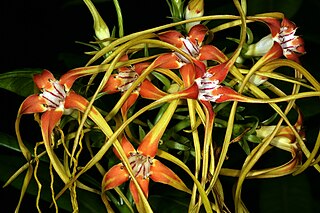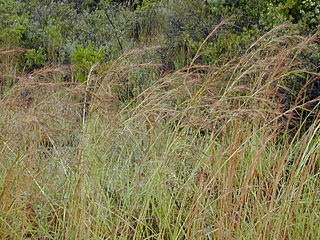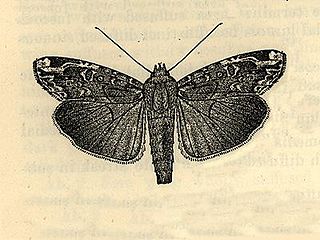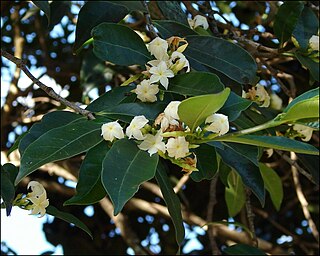There are a number of systems of transport in the Comoros. The Comoros possesses 880 km (547 mi) of road, of which 673 km (418 mi) are paved. It has three seaports: Fomboni, Moroni and Moutsamoudou, but does not have a merchant marine, and no longer has any railway network. It has four airports, all with paved runways, one with runways over 2,438 m (7,999 ft) long, with the others having runways shorter than 1,523 m (4,997 ft).

The olive bee-eater or Madagascar bee-eater is a near passerine bee-eater species in the genus Merops. It is native to the southern half of Africa where it is present in Angola; Botswana; Burundi; Comoros; Democratic Republic of the Congo; Djibouti; Eritrea; Ethiopia; Kenya; Madagascar; Malawi; Mayotte; Mozambique; Namibia; Rwanda; Somalia; South Sudan; Sudan; Tanzania; Uganda; Zambia; Zimbabwe. It is a common species with a wide range so the International Union for Conservation of Nature has rated their conservation status as "least concern".

Ocimum is a genus of aromatic annual and perennial herbs and shrubs in the family Lamiaceae, native to the tropical and warm temperate regions of all 6 inhabited continents, with the greatest number of species in Africa. It is the genus of basil and its best known species are the cooking herb great basil, O. basilicum, and the medicinal herb tulsi, O. tenuiflorum.

Strophanthus is a genus of flowering plants in the family Apocynaceae, first described as a genus in 1802. It is native primarily to tropical Africa, extending to South Africa, with a few species in Asia from southern India to New Guinea and southern China. The genus name is a compound of the Greek words στροφος (strophos) "twisted" and ανθοσ (anthos) "flower", in reference to the corolla lobes which, in some species - notably S. petersianus - resemble long twisted ribbons or threads and can reach a length of 30–35 cm. This trait, in addition to colouring involving combinations of bright pinks, purples and oranges, combine to make the flowers among the most ornamental in the plant kingdom.
Tannodia is a plant genus of the family Euphorbiaceae first described as a genus in 1861. It is native to Africa, Madagascar, and Comoros. It is dioecious.
- Tannodia congolensis - Zaïre
- Tannodia cordifolia - Comoros, Madagascar
- Tannodia grandiflora - Diana Region in Madagascar
- Tannodia nitida - Atsinanana in Madagascar
- Tannodia obovata - Atsinanana in Madagascar
- Tannodia pennivenia - Atsinanana in Madagascar
- Tannodia perrieri - Madagascar
- Tannodia swynnertonii - Tanzania, Mozambique, Zimbabwe
- Tannodia tenuifolia - Kenya, Tanzania, Malawi, Mozambique, Zimbabwe, Zambia

Angraecopsis is a genus of plants in the family Orchidaceae. It was first described by Fritz Kraenzlin in 1900 and given its name on account with the genus' similarity to Angraecum species. Angraecopsis are native to Africa, Madagascar, Réunion, Mauritius and the Comoros. The growth habit is rather small and the leaves emerge from a woody stem.

Mimusops is a genus of plants in the family Sapotaceae described as a genus by Linnaeus in 1753.

Secamone is a genus of plant in family Apocynaceae, first described as a genus in 1810. It is widespread across much of Africa, northern Australia, southern Asia, with numerous species endemic to Madagascar.

Eleusine is a genus of Asian, African, and South American plants in the grass family, sometimes called by the common name goosegrass. One species, Eleusine indica, is a widespread weed in many places. Another species, Eleusine coracana, is finger millet, cultivated as a cereal grain in India and parts of Africa.

Hyparrhenia is a genus of grasses. Many species are known commonly as thatching grass.

Eublemma is a genus of moths of the family Erebidae described by Jacob Hübner in 1829.

Magusa is a genus of moths of the family Noctuidae first described by Francis Walker in 1857.

Sacciolepis is a genus of plants in the grass family. Cupscale grass is a common name for plants in this genus.

Microcoelia is a genus of orchids native to sub-Saharan Africa as well as to Madagascar and other islands of the Indian Ocean.
- Microcoelia aphylla(Thouars) Summerh. - from Kenya and Uganda south to KwaZulu-Natal, plus Madagascar, Mauritius and Réunion
- Microcoelia aurantiaca(Schltr.) Summerh. - Madagascar
- Microcoelia bispiculataL.Jonss. - Madagascar
- Microcoelia bulbocalcarataL.Jonss. - Príncipe, Cameroon, Gabon, Uganda, Rwanda
- Microcoelia caespitosa(Rolfe) Summerh. in J.Hutchinson & J.M.Dalziel - western and central Africa from Liberia to Zaïre and Uganda
- Microcoelia corallinaSummerh. - Tanzania, Mozambique, Malawi
- Microcoelia cornuta(Ridl.) Carlsward - Madagascar, Comoros
- Microcoelia decaryanaL.Jonss. - Madagascar
- Microcoelia dolichorhiza(Schltr.) Summerh. - Madagascar
- Microcoelia elliotii(Finet) Summerh. - Madagascar
- Microcoelia exilisLindl. - from Kenya and Uganda south to KwaZulu-Natal, plus Madagascar
- Microcoelia gilpinae(Rchb.f. & S.Moore) Summerh. - Madagascar
- Microcoelia globulosa(Hochst.) L.Jonss. - from Nigeria east to Eritrea, south to Angola and Zimbabwe
- Microcoelia hirschbergiiSummerh. - Zaïre, Zambia
- Microcoelia jonssoniiSzlach. & Olszewski - Central African Republic
- Microcoelia koehleri(Schltr.) Summerh. - from Nigeria to Tanzania, south to Zimbabwe
- Microcoelia konduensis(De Wild.) Summerh - western and central Africa
- Microcoelia leptostele(Summerh.) L.Jonss. - Central African Republic, Zaïre
- Microcoelia macrantha(H.Perrier) Summerh. - Madagascar
- Microcoelia macrorhynchia(Schltr.) Summerh. in J.Hutchinson & J.M.Dalziel - central Africa
- Microcoelia megalorrhiza(Rchb.f.) Summerh. - Kenya, Tanzania, Malawi
- Microcoelia microglossaSummerh. - central Africa
- Microcoelia moreauaeL.Jonss - Kenya, Tanzania, Zimbabwe
- Microcoelia nyungwensisL.Jonss. - Rwanda
- Microcoelia obovataSummerh. - from Kenya south to KwaZulu-Natal
- Microcoelia ornithocephalaP.J.Cribb - Malawi
- Microcoelia perrieri(Finet) Summerh. - Madagascar
- Microcoelia physophora(Rchb.f.) Summerh. - Kenya, Tanzania, Madagascar
- Microcoelia sanfordiiL.Jonss - Cameroon
- Microcoelia smithii(Rolfe) Summerh. - Kenya, Tanzania, Malawi
- Microcoelia stolzii(Schltr.) Summerh. - Kenya, Tanzania, Malawi, Mozambique, Zambia, Zimbabwe
These are a list of matches played by the Mauritius national football team from 1970 to 1979. These were the first games played by Mauritius as an independent nation.
Euchromius klimeschi is a species of moth in the family Crambidae. It is found in Ethiopia, Somalia, Kenya, Tanzania, Zaire, Zambia, Zimbabwe, Madagascar, Mozambique, South Africa and Namibia.
Euchromius locustus is a species of moth in the family Crambidae. It is found in Tanzania, Zaire and Zambia.
Euchromius matador is a species of moth in the family Crambidae. It is found in eastern Zaire and western Tanzania. The habitat consists of moist woodland, savanna areas and montane areas.

Pycnostachys is a genus of plants in the family Lamiaceae, first described in 1826. It is native to sub-Saharan Africa including Madagascar.
- Pycnostachys abyssinicaFresen. - Ethiopia
- Pycnostachys angolensisG.Taylor - Angola
- Pycnostachys batesiiBaker - Cameroon, Zaïre, Sudan, Uganda
- Pycnostachys chevalieriBriq. - Central African Republic
- Pycnostachys ciliataBramley - Tanzania, Malawi, Mozambique, Zambia
- Pycnostachys coeruleaHook. - East Africa from Ethiopia to Botswana; Madagascar
- Pycnostachys congensisGürke - Zaïre, Zambia
- Pycnostachys de-wildemanianaRobyns & Lebrun - East Africa from Burundi to Zimbabwe
- Pycnostachys deflexifoliaBaker - Kenya, Tanzania, Uganda
- Pycnostachys descampsiiBriq. - Zaïre
- Pycnostachys elliotiiS.Moore - Zaïre, Uganda
- Pycnostachys eminiiGürke - from Cameroon to Ethiopia + Tanzania
- Pycnostachys erici-roseniiR.E.Fr - Zaïre, Uganda, Burundi, Rwanda
- Pycnostachys goetzeniiGürke - Zaïre, Uganda, Rwanda
- Pycnostachys gracilisR.D.Good - Angola
- Pycnostachys graminifoliaPerkins - Tanzania
- Pycnostachys kassneriDe Wild - Zaïre, Zambia, Tanzania
- Pycnostachys lancifoliaBramley - Tanzania
- Pycnostachys meyeriGürke - western + central Africa
- Pycnostachys nepetifoliaBaker - Kenya
- Pycnostachys niamniamensisGürke - South Sudan, Kenya, Uganda
- Pycnostachys orthodontaGürke - Zimbabwe, Mozambique, Zambia, Tanzania
- Pycnostachys parvifoliaBaker - Zambia, Tanzania, Malawi
- Pycnostachys prittwitziiPerkins - Zambia, Tanzania
- Pycnostachys pseudospeciosaBuscal. & Muschl. - Zaïre, Zambia
- Pycnostachys recurvataRyding - Ethiopia
- Pycnostachys reticulata(E.Mey.) Benth. - central + southern Africa
- Pycnostachys ruandensisDe Wild. - east-central Africa
- Pycnostachys schliebeniiMildbr. - east-central Africa
- Pycnostachys schweinfurthiiBriq - western + central Africa
- Pycnostachys speciosaGürke - Kenya, Uganda, Tanzania, Rwanda
- Pycnostachys sphaerocephalaBaker - Zambia, Tanzania, Malawi, Zaïre
- Pycnostachys stuhlmanniiGürke - central Africa
- Pycnostachys umbrosa(Vatke) Perkins - Kenya, Tanzania
- Pycnostachys urticifoliaHook. - southeastern Africa
- Pycnostachys verticillataBaker - Zambia, Tanzania

Mascarenhasia is a genus of plant in family Apocynaceae first described as a genus in 1844. It is native to Africa and a few islands in the Indian Ocean. Several species are endemic to Madagascar.
- Mascarenhasia arborescensA.DC. - Kenya, Tanzania, Zaire, Malawi, Mozambique, Zimbabwe, Comoros, Madagascar; naturalized in Seychelles
- Mascarenhasia havetiiA.DC. - Madagascar
- Mascarenhasia lanceolataA.DC. - Madagascar
- Mascarenhasia lisianthifloraA.DC. - Madagascar
- Mascarenhasia macrosiphonBaker - Madagascar
- Mascarenhasia rubraJum. & H.Perrier - Madagascar
- Mascarenhasia speciosaScott-Elliot - Madagascar
- Mascarenhasia tampinensisPichon - Madagascar













